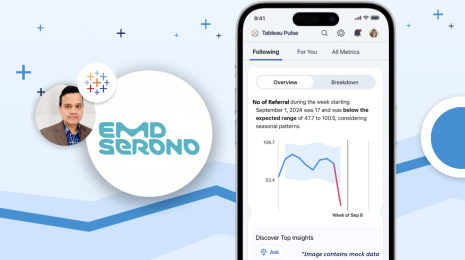Achieve AI success with a people-first data strategy
Editor’s note: This article originally appeared in Forbes.
For many years, the underlying complexities of AI, paired with a dramatic portrayal in the media as an inevitable replacement for human jobs, created a daunting narrative that made AI difficult for most people to understand, let alone to widely adopt. Now, we’re at an exciting turning point with AI. We're beginning to understand and articulate where AI is useful for elevating people's creativity and augmenting decision making. As the pandemic has accelerated digital transformation, organizations are successfully deploying and scaling AI projects across more sophisticated, critical scenarios.
“Eighteen months back, 85% of the enterprises that we surveyed were actually experimenting,” said Nitin Mittal, a principal at Deloitte, specializing in AI and strategic growth. “They had data science groups, they had an AI center of excellence, they had investments, they were developing proof of concepts—trying to figure out the art of the possible. After just 18 months, more than 40% of those organizations are starting to adopt AI at scale.”
So what’s changed? Organizations are not just focused on the technology elements of AI—they’re taking a strategic, human-centric approach that balances machine intelligence with human expertise. They're creating environments of trust, where people not only have the right data for building useful models, but understand the capabilities and limitations of AI and its outputs. After all, we can't forget that the purpose of these technologies is to improve people’s data-driven decision making.
Let’s look at a few focus areas of a people-centric strategy to help you achieve trusted data and successful AI projects: your data architecture, the processes for managing governed data, and balancing the roles of people and machines.
Lay a strong foundation with your data architecture
“I think one of the most important things I see people do right, is to make sure that you build the data foundation from the ground up correctly,” said Ali Ghodsi, CEO of Databricks. This starts with internal alignment—both organizationally and in terms of use cases and common goals.
Your analysts, data scientists, data engineers, and machine learning engineers will offer unique viewpoints and preferences, and should all be brought into the conversation as experts in their areas of the business. A chief data officer and center of excellence will help in establishing ownership of the data and AI strategy, so as not to throw funding at uncoordinated or siloed efforts.
Ali adds, “There’s a lot of stuff you have to do under the hood that you’ve got to get right—that your models are stored in the correct way, that you can reproduce your machine learning models, that you’re handling privacy in the right way—so it’s really important that you have an architecture that's built for AI from the ground up.”
The data lakehouse is one such architecture—with “lake” from data lake and “house” from data warehouse. This modern, cloud-based data stack enables you to have all your data in one place while unlocking both backward-looking, historical analysis as well as forward-looking scenario planning and predictive analysis. This kind of technology investment enables a broader set of data users to get value from your data within one platform—from business users doing traditional reporting and real-time analysis to data scientists working with algorithms for personalization, automation, and forecasting demand.
Invest in strong data management and governance up front—it pays off downstream
“Preparing data, classifying data, and tagging data so that it is machine consumable—as opposed to human consumable—is another artifact of organizations that have cracked the code,” Nitin shared of Deloitte’s findings. As data is the foundation of an AI system, the quality and reliability of AI-enabled prescriptive recommendations or automations are directly correlated to the quality and reliability of the data used to train the system. Trustworthy data can also remove a potential layer of complexity when validating that algorithms and their recommendations are transparent, ethical, and accurate.
Organizations that lack sound data management practices or that have struggled to build traction and confidence in their data and analytics deployment stand little chance of successfully embracing AI. The same principles that have made self-service analytics possible at scale—a people-first approach to your data strategy, including a governance framework that ensures trust in data—are critical in the success of AI projects.
“Our data strategy assures convergence on what we call the ‘golden rules’ in our decision supply chain,” said Una Shortt, VP of Data Platform and Engineering at Schneider Electric. “These rules are globally shared and they're published for everybody to access through a defined data catalog.” Setting this standard ensures that every team's systems use data from company-governed authoritative sources, including harmonized data and data objects built for reuse across analytics projects.
With these golden rules, data is everyone's business at Schneider Electric—not just an IT process. The upfront work to prep, clean, and govern the data means there are fewer downstream issues with quality and trust. “A shared data governance framework assures our users that if they're reusing a published, certified data object in our company, their colleagues are adopting this exact same view of the data,” shared Una. “We understand that when data is reliable, well structured, reusable, and trustworthy, it becomes a key accelerator for our business.”
Harmonize human and machine capabilities to build trust in AI
While machines are great at analyzing huge amounts of data (and getting better at finding hidden correlations in limited data sets), we still rely on people for long-term planning, abstract and creative thinking, and discerning causality from correlation. For this reason, AI projects need the domain experience of people who know your business and who can frame the data and AI results in the right context. By design, tools should explain the provenance of their recommendations to people, so they can make informed decisions—no one should passively accept AI recommendations.
As Deloitte’s Nitin puts it, “Humans are working with and interacting with intelligent machines, so this notion of having human-centered AI experiences is absolutely critical.” AI offers incredible promise when we can balance its strengths with the creativity of human expertise. In short, people should always be in control of their relationship with AI.
At Tableau and Salesforce, we believe that a people-first approach to your data strategy—combining the right architecture, tools, and processes—will help everyone trust the data and the AI applications it powers. Then, you’ll have a solid foundation for everyone to better understand and embrace AI in their decision making.
Want to learn more? Check out our AI analytics solutions.








